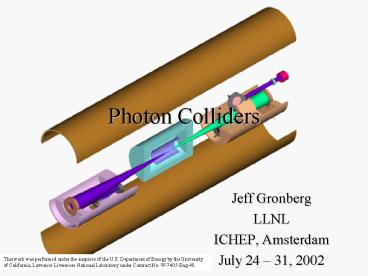Photon Colliders - PowerPoint PPT Presentation
Title:
Photon Colliders
Description:
The workhorses of particle physics at the energy frontier have been e e- and pp ... Core laser technology will be prototyped and demonstrated within the year ... – PowerPoint PPT presentation
Number of Views:24
Avg rating:3.0/5.0
Title: Photon Colliders
1
Photon Colliders
- Jeff Gronberg
- LLNL
- ICHEP, Amsterdam
- July 24 31, 2002
This work was performed under the auspices of the
U.S. Department of Energy by the University of
California, Lawrence Livermore National
Laboratory under Contract No. W-7405-Eng-48.
2
gg collisions Casting new light on Particle
Interactions
- The workhorses of particle physics at the energy
frontier have been ee- and pp collisions - Stable, charged particles can be accelerated and
focused - But other particle interaction can have unique
physics reach - Virtual gg collisions have been studied at ee-
machines - Technique for producing real photon collisions
through Compton backscattering proposed by
Ginzburg et al. in 80s - The technology is becoming mature to produce
collisions of real photons at high energy
Photon collisions produce anything that has
electric charge
- Production is model independent, electromagnetic
coupling only - Control of photon polarization allows couplings
to be probed - See talk of S. Soldner-Rembold for complete
discussion of gg physics reach
3
Photon collisions provide a unique probe of
physics at high energies
No future accelerator will ever directly probe
the unification scale
But gg can indirectly probe arbitrarily high mass
scales
Because the Higgs couples to mass, all charged
particles contribute, independent of their mass
The largest machine ever proposed would only go
to 100 TeV
The existence of new generations of quarks and
leptons can thus be detected in regions not
directly accessible
4
Photon Colliders The marriage of lasers and
electron linear colliders
5
Simulations and parameterizations describe the
luminosity
- Compton backscattering is complicated
- Polarization dependent
- Energy dependent
- Laser Intensity dependent
- Energy / Angle correlation
- Full simulations exist
- Code from V. Telnov
- CAIN simulation from P. Chen et al.
- Luminosities have been parameterized
- CompAZ from A. Zarnecki
- CIRCE from T. Ohl
From hep-ex/0207021 A. Zarnecki
6
Required laser technology pushes the state of the
art
- High Average Power, Short-Pulse Lasers
- Terawatt peak power - 1 Joule in 1 ps
- 20 kilowatts average power
- Near diffraction limit
- Time structure matched to the electron beam
- Laser focusing optics
- Co-located in the beam pipe vacuum
- Cannot interfere with
- The accelerator
- The detector
7
The Mercury laser will utilize three key
technologies gas cooling, diodes, and YbS-FAP
crystals
DM
Goals 100 J 10 Hz 10 electrical
2-10 ns
vacuum relay
front end
gas-cooled amplifier head
Injection and reversor
100 Joules enough power for one train of 95
electron bunches
8
MERCURY output must be time structured to match
the electron bunches
Beam Splitter
Laser Plant
1, 100 Joule pulse -gt 100, 1 Joule pulses
12 Lasers x 10Hz 120Hz
- Laser plant for NLC / JLC lt 200M
9
MERCURY commissioning has begunOne amplifier
head with 4 of 7 crystals installed
- Status
- Producing 10 Joule pulses at 0.1 Hz
- Theoretical max 14 Joules w/ 4 crystals
- Operation of two heads with 14 crystals
- within the next year
- Installation of new front end for 10Hz
operation
10
NLC solution might be adapted to TESLA, but TESLA
bunch spacing opens new options
- A single light pulse can travel around the ring
and hit every bunch in the TESLA train - DESY and Max Born Institute will prototype a
scale model - Tolerances are tight, but enormous savings in
laser power
11
System Integration Optics/Beampipe
- Essentially identical to the ee- IR
- All masking preserved
- 30 mRad x-angle
- Extraction line 10 mRadian
- New mirror design 6 cm thick, with central hole 7
cm radius. - Remove all material from the flight path of the
backgrounds
12
gg Engineering Test Facility at SLCRevive SLC
and install beampipe with optics
Beam Energy DR g?x,y (m-rad) FF g?x,y (m-rad) ?x
/ ?y ? z ?x,y N?
30 GeV 1100 / 50 1600 / 160 8 / 0.1 mm 0.1 1.0
mm 1500/55nm 6.0E9
13
Conclusions
- Photon collisions provide new physics reach
- Laser technology is maturing, driven by other
applications - Core laser technology will be prototyped and
demonstrated within the year - A basic design for the integration of the optics
with the detector/accelerator exists - Ready for prototyping and demonstration at a low
energy linear ee- collider































